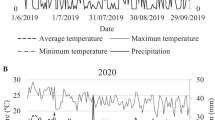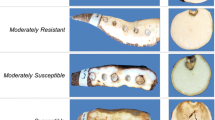Abstract
In this study, genotype by environment (G × E) interaction and biological stability of resistance to Phytophthora infestans were analyzed for 22 potato cultivars, using multidimensional statistical methods. Sergen 3 computer program, based on multiplicative model was applied to analyze the G × E interaction and regression analysis. The potato cultivars were tested in four experiments in Central and South-eastern Poland over a 4 year period. The analysis of variance of rAUDPC values indicated significant (P < 0.01) influence of genotype (=cultivar) (G), year (Y), environment (E) and G × E interaction. The applying multidimensional statistical methods revealed that the most stable resistance is expressed by highly resistant cultivars Bzura, Wawrzyn, Meduza and moderately resistant ones Klepa, Jasia, Nimfy, Ania, Hinga, Vistula. For these cultivars all tested interactions (with year, location and environment) were insignificant. Such cultivars can be recommended for cultivation across all environments in Poland. In the group of unstable cultivars, two subgroups were separated: unstable and unpredictable (12 cvs.) and unstable and regular (1 cv). A different response of potato cultivars to environmental factors suggests that there is a need to select potato cultivars which are stable in terms of late blight resistance expression at various locations and years.
Resumen
En este estudio se analizaron la interacción genotipo ambiente (G x E) y la estabilidad biológica de resistencia a Phytophthora infestans para 22 cultivares de papa, utilizando métodos estadísticos multidimensionales. Se aplicó el programa de computación Sergen 3, basado en un modelo multiplicativo para analizar la interacción G x E y para el análisis de regresión. Se probaron las variedades de papa en cuatro experimentos en el centro y el sureste de Polonia, en un período de cuatro años. Los valores del análisis de varianza de rAUDPC indicaron influencia significativa (P < 0.01) del genotipo (=variedad) (G), año (Y), ambiente (E), y la interacción G × E. La aplicación de los métodos estadísticos multidimensionales revelaron que la resistencia más estable se expresa por las variedades altamente resistentes Bzura, Wawrzyn, Meduza, y con las de resistencia moderada Klepa, Jasia, Nimfy, Ania, Hinga y Vistula. Todas las pruebas de interacción para estas variedades (con año, localidad y ambiente) fueron significativas. Tales variedades se pueden recomendar para cultivo en todos los ambientes en Polonia. El grupo de las variedades inestables se separó en dos subgrupos; inestables e impredecibles (12 vars.) y las inestables regulares (una var.). La diferente respuesta de las variedades a los factores ambientales sugiere que existe la necesidad de seleccionar variedades de papa que son estables en términos de expresión de resistencia al tizón tardío en varias localidades y años.

Similar content being viewed by others
References
Becker, H.C., and J. Leon. 1988. Stability analysis in plant breeding. Plant Breeding 101: 1–23.
Bujak, H., A. Dopierała, P. Dopierała, and K. Nowosad. 2006. Analiza interakcji genotypowo-środowiskowej plonu odmian żyta ozimego. Biul IHAR 240/241: 151–160. California PestCast 2005.
Caliński, T., S. Czajka, and Z. Kaczmarek. 1997. A multivariate approach to analyzing genotype-environment interactions. In Advances in biometrical genetics, 3–14, Poznań, ed. W: Krajewski P., Kaczmarek Z.
Caliński, T., S. Czajka, Z. Kaczmarek, P. Krajewski, and I. Siatkowski. 1998. Podręcznik użytkownika programu Sergen 3. Instytut Genetyki Roślin PAN w Poznaniu.
Chotkowski, J., and I. Stypa. 2004. Odmiany ziemniaków. Charakterystyka tabelaryczna. Bonin Koszalin 2004.
Colon, L.T. 1994. Resistance to Phytophthora infestans in Solanum Tuberosum and wild Solanum species. Doctoral Thesis, Wageningen Agricultural University, pp. 11.
Colon, L.T., and D.J. Budding. 1988. Resistance to late blight (Phytophthora infestans) in ten wild Solanum species. Euphytica 77–87.
Colon, L.T., D.J. Budding, and J. Hoogendoorn. 1995. Breeding for foliar resistance to Phytophthora infestans in potato: the influence of test conditions on the results of screening for field resistance. In Phytophthora infestans 150, ed. L. Dowley, E. Bannon, L. Cooke, T. Keane, and E. O’Sullivan, 282–288. Dublin: Boole Press Ltd.
Colon, L.T, B.J. Nielsen, and U. Darsow. 2004. Eucablight protocol-Field test for foliage blight resistance. (www.eucablight.org).
Cygert, H., Z. Królikowski, J. Kaczmarek, and J. Adamczyk. 2003. Ocena współdziałania genotypowo-środowiskowego dla plonu ziarna mieszańców kukurydzy (Zea mays L.). Biul IHAR 226(227/2): 365–376.
Dorrance, A.E., and D.A. Inglis. 1997. Assessment of greenhouse and laboratory screening methods for evaluating potato foliage for resistance to late blight. Plant Disease 81: 1206–1213.
Eberhart, S.A., and A. Russell. 1966. Stability parameters for comparing varieties. Crop Science 6: 36–40.
Forbes, G.A., M.G. Chacon, H.G. Kirk, M.A. Huarte, M. Van Damme, S. Distel, G.R. Mackay, H.E. Stewart, R. Lowe, J.M. Duncan, H.S. Mayton, W.E. Fry, D. Andrivon, D. Ellisseche, R. Pelle, H.W. Platt, G. MacKenzie, T.R. Tarn, L.T. Colon, D.J. Budding, H. Lozoya-Saldana, A. Hernandez-Vilchis, and S. Capezio. 2005. Stability of resistance to Phytophthora infestans in potato: an international evaluation. Plant Pathology 54: 364–372.
Francis, T.R., and L.W. Kannenberg. 1978. Yield stability studies in short-season maize. I. A descriptive method for grouping genotypes. Canadian Journal of Plant Science 58: 1029–1034.
Fry, W.E. 1978. Quantification of general resistance of potato cultivars and fungicide effects for integrated control of potato late blight. Phytopathology 68: 1650–1655.
Gauch, H.G. 1988. Model selection and validation for yield trials with interaction. Biometrics 44: 705–715.
Gauch, H.G., and R.W. Zobel. 1989. AMMI analysis of yield trials. Additive main effects and multiplicative interaction analysis of two international maize cultivars trials. Crop Science 30: 493–500.
Haynes, K.G., D.H. Lambert, B.J. Christ, D.P. Weingartner, D.S. Douches, J.E. Backlund, G. Secor, W. Fry, and W. Stevenson. 1998. Phenotypic stability of resistance to late blight in potato clones evaluated at eight sites in the United States. American Journal of Potato Research 75: 211–217.
Haynes, K.G., B.J. Christ, D.P. Weingartner, D.S. Douches, C.A. Thill, G. Secor, W.E. Fry, and D.H. Lambert. 2002. Foliar resistance to late blight in potato clones evaluated in national trials in 1997. American Journal of Potato Research 79(6): 451–457.
Inglis, D.A., D.A. Johnson, D.E. Legard, W.E. Fry, and P.B. Hamm. 1996. Relative resistance of potato clones in response to new and old populations of Phytophthora infestans. Plant Disease 80: 575–578.
Kaczmarek, Z. 1986. Analiza doświadczeń wielokrotnych zakładanych w blokach niekompletnych. Roczn. Akad. Rol. w Poznaniu, Rozprawy Naukowe, Zeszyt 155.
Kaczmarek, J., A. Kotecki, L. Kotowicz, and R. Weber. 2003. Interakcja genotypowo-środowiskowa plonowania odmian rzepaku ozimego w doświadczeniach PDO. Biul IHAR 226(227/2): 395–403.
Lin, C.S., M.R. Binns, and L.P. Lefkovitch. 1986. Stability analysis: Where do we stand? Crop Science 26: 894–900.
Lung’ aho, C.L., N. Naganga, and H.M. Kidanemariam. 1997. Evaluation of improved potato lines for resistance to late blight in Kenya. In: Proceedings of 4 th African Potato Association Meeting, Pretoria. S. Africa, 23–28 February 1997: 73–75.
Mądry, W., and A. Rajfura. 2003. Analiza statystyczna miar stabilności na podstawie danych w klasyfikacji genotyp × środowiska. Część I. Model mieszany Scheffégo-Calińskiego i model regresji łącznej. Colloquium Biometryczne: 181–206. Minnesota.
Mądry, W., and M.S. Kang. 2005. Scheffé-Caliński and Shukla models: Their interpretation and usefulness in stability and adaptation analyses. Journal of Crop Improvement 14(1/2): 325–369.
Mulema, J.M.K., O.M. Olanya, E. Adipala, and W. Wagoire. 2004/5. Stability of late blight resistance in population B potato clones. Potato Research 47: 11–24.
Oleksiak, T., and D.R. Mańkowski. 2003. Ocena stabilności plonowania wybranych odmian pszenicy ozimej na podstawie wyników badań ankietowych z lat 1990–2001. Biul IHAR 228: 3–11.
Oleksiak, T., and D.R. Mańkowski. 2005. Interakcja odmian pszenicy ozimej w zmiennych warunkach środowiskowych na podstawie wyników badań ankietowych. Biul IHAR 235: 5–11.
Oleksiak, T., and D.R. Mańkowski. 2006. Analiza stabilności plonowania odmian pszenżyta ozimego w przestrzeni rolniczej Polski. Folia University Agricultural Stein Agricultura 247(100): 133–140.
Parker, J.M., H.D. Thurston, M.J. Villareal-Gonzalez, and W.E. Fry. 1992. Stability of disease expression in the potato late blight pathosystem: A preliminary field study. American Journal of Potato Research 69: 635–644.
Piepho, H.P. 1998. Methods for comparing the yield stability of cropping systems-a review. Journal of Agronomy and Crop Science 180: 193–213.
Pietkiewicz, J.B. 1972. Badania odporności ziemniaka na zarazę ziemniaczaną (Phytophthora infestans (Mont.) de Bary) na odciętych liściach. Biuletyn Instytutu Ziemiaka 9: 17–32.
Scheffe, H. 1959. The analysis of variance. New York: Wiley.
Sieczka, M.T., B. Flis, and M. Pakosińska. 1997. Metody selekcji stosowane w syntezie tetraploidalnych materiałów wyjściowych odpornych na patogeny. Biuletyn Instytutu Ziemiaka 48/I: 45–53.
Stewart, H.E., P.H. Flavelle, D.C. McCalmont, and R.L. Wastie. 1983. Correlation between glasshouse and field test for resistance to foliage blight caused by Phytophthora infestans. Potato Research 26: 41–48.
Świeżyński, K.M., K.G. Haynes, R.C.B. Hutten, M.T. Sieczka, P. Watts, and E. Zimnoch-Guzowska. 1997. Pedigree of European and North-American potato varieties. Plant Breeding and Seed Science, supplement to vol 41, nr 1.
Toxopeus, H.J. 1956. Reflections on the origin of new physiologic races in Phytophthora infestans and the breeding for resistance in potatoes. Euphytica 5: 221–237.
Umaerus, V., M. Umaerus, L. Erjefalt, and B.A. Nilsson. 1983. Control of Phytophthora by host resistance: Problems and progress. In Phytophthora: Its biology, taxonomy, ecology, and pathology, ed. D.C. Erwin, S. Bartnicki-Garcia, and P.H. Tsao, 315–326. St. Paul: American Phytopathological Society.
Weber, R., and D. Zalewski. 2005. Plonowanie odmian pszenicy ozimej w warunkach Dolnego Śląska. Annales UMCS, Sec. E, 60: 59–70.
Weber, R., D. Zalewski, and L. Kotwicz. 2003. Stabilność plonowania odmian pszenicy ozimej na Dolnym Śląsku. Biul IHAR 226(227/1): 115–125.
Wricke, G. 1962. Evaluation method for recording ecological differences in field trials. Zeitschrift Fur Pflanzenzuchtung 47: 92–96. in German.
Wulff, E.G., W. Perez, R.J. Nelson, J. Bonierbale, A. Landeo, and G.A. Forbes. 2007. Identification of stable resistance to Phytophthora infestans in potato genotypes evaluated in field experiments in Peru. Experimental Agriculture 43: 353–363.
Author information
Authors and Affiliations
Corresponding author
Rights and permissions
About this article
Cite this article
Tatarowska, B., Flis, B. & Zimnoch-Guzowska, E. Biological Stability of Resistance to Phytophthora infestans (Mont.) de Bary in 22 Polish Potato Cultivars Evaluation in Field Experiments. Am. J. Pot Res 89, 73–81 (2012). https://doi.org/10.1007/s12230-011-9222-3
Published:
Issue Date:
DOI: https://doi.org/10.1007/s12230-011-9222-3




